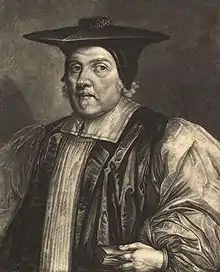Richard Sterne | |
|---|---|
| Archbishop of York | |
 | |
| In office | 1664–1683 |
| Predecessor | Accepted Frewen |
| Successor | John Dolben |
| Personal details | |
| Born | c. 1596 Mansfield, Nottinghamshire |
| Died | 1683 |
| Alma mater | Trinity College, Cambridge |

Richard Sterne (c. 1596–1683) was a Church of England priest, Archbishop of York from 1664 to 1683.
Life
He was educated at Trinity College, Cambridge, where he graduated MA in 1618, BD in 1625 and DD in 1635.[1] He was elected a fellow of Benet College (now Corpus Christi College), Cambridge in 1623 and then served as Master of Jesus College, Cambridge, from 1634.
Around 1633, he became chaplain to Archbishop Laud. From 1642, he held the rectories of Yeovilton and Harleton. A Royalist, he was arrested and imprisoned by the Parliamentarians later the same year. In 1644, he was formally dismissed as Master of Jesus and, in 1645, he lost his rectories, although he was released from prison.
At the Restoration in 1660, Sterne was appointed Bishop of Carlisle — he was elected to the See on 15 November 1660, confirmed 1 December, and consecrated a bishop on 2 December 1660.[2] From there he was translated to York in 1664 — he was elected to that See on 28 April and confirmed on 31 May.[3] He is said to have been one of those who assisted in revising the Book of Common Prayer in 1662. He also assisted Brian Walton with the English Polyglot Bible and himself wrote Summa Logicae (published posthumously in 1685). He founded scholarships at both Corpus Christi and Jesus Colleges.
His great-grandson Laurence Sterne attended Jesus College, Cambridge, and would find literary fame in the 1760s as author of The Life and Opinions of Tristram Shandy, Gent. and live as a curate and parson in Yorkshire.
References
- ↑ "Sterne, Richard (STN611R)". A Cambridge Alumni Database. University of Cambridge.
- ↑ Fasti Ecclesiae Anglicanae 1541–1857, vol. 11, 2004, pp. 9–14
- ↑ Fasti Ecclesiae Anglicanae 1541–1857, vol. 4, 1975, pp. 1–5
Sources
- Chisholm, Hugh, ed. (1911). . Encyclopædia Britannica. Vol. 25 (11th ed.). Cambridge University Press.
- Pollard, Albert Frederick (1898). . In Lee, Sidney (ed.). Dictionary of National Biography. Vol. 54. London: Smith, Elder & Co.
- Pollard, A. F.; Spurr, John. "Sterne, Richard (1595/6–1683)". Oxford Dictionary of National Biography (online ed.). Oxford University Press. doi:10.1093/ref:odnb/26413. (Subscription or UK public library membership required.)